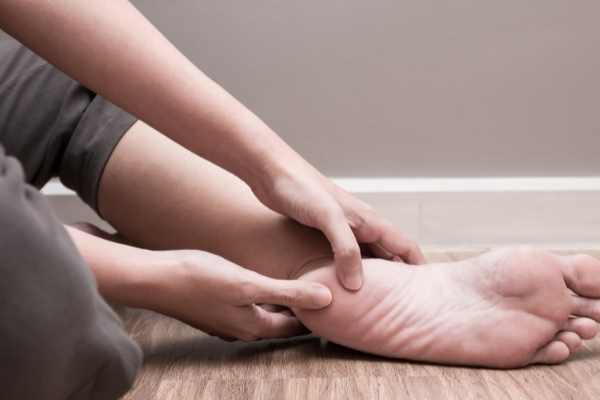Plantar fasciitis is when you have pain in your heel area. It is the inflammation of the tissue located at the bottom of your heels.
While having this condition, one usually feels an achy, dull kind of pain that originates from the heels and goes down to the bottom of the feet.
In about 80 percent of the cases, both feet have affected that range from minute to the extreme. Excellent and right shoes help to relieve this problem. Also, check out our guide on the best running shoes for men with plantar fasciitis.
Causes of Plantar Fasciitis:
There are several causes of plantar fasciitis. The most common cause of it is wearing non-supportive footwear for long periods.
The tension and strain development in the fascia causes wear and tears in that particular area. People having long job routines or those working out on hard surfaces are the most affected people.
Symptoms:
There are a lot of symptoms of Plantar Fasciitis. People with this condition mention paining heels when they get up in the morning or when they have been sitting for an excessive amount of time.
Moreover, the pain gradually increases as months pass by.
Furthermore, the discomfort is accompanied by swelling in the heel area. For some people, the pain subsides by walking because of stretched fascia but returns after spending long periods on their feet.
Also read: How to dry shoes
Buyers Guide to Buy Good Shoes to Relief from Plantar Fasciitis
A specific factor needs to be kept in mind when buying a shoe that gives you the maximum support regarding feet condition like Achilles tendonitis, plantar fasciitis, or heel spurs.
Each factor that has been described below plays a significant role in deciding your future shoe. One should keep an eye on the characteristics and then make a decision.
Also read: How to Stop Shoes from Squeaking
Strong Cushioning:
The first and most important factor is the degree of cushioning provided by the shoe. Cushioning is the amount of force that is absorbed by the shoe when it strikes the ground.
A Strong cushioned shoe has a much more comfortable environment making the user much more relative ease.
Cushioning depends upon the shoe’s insole; where a shoe has a high-quality insole will be more effective.
A low-quality sole will damage the muscles of the feet. Sometimes just an insole is not enough to provide the best cushioning.
To cope with that deficiency, a removable sock liner is used to enhance the cushioning. One should always opt for a shoe that provides good cushioning.
Strong Arch support:
Arch supports are inserts that are positioned in the arch of the shoe. It usually relieves the pain of those who find it troubling walking caused to common foot problems.
Arch supports serve the purpose of aligning your foot to the natural movement by releasing the stress generated in your arch whenever your foot strikes the ground.
It usually helps you to distribute the strain arches to provide stability to the foot.
You should always consider buying a shoe with arch support to eliminate any chance of pain caused by plantar fasciitis. All of the boots mentioned in our reviews article have strong arch support.
Excessive pronation
The third important factor is the excessive pronation or the over-pronation of the shoe. Pronation happens when a person rolls their feet inward when the feet touch the ground.
All the mass of the body transfers from the heel to the toe, resulting in the foot being bent inwards.
Pronation is a natural phenomenon in which the body absorbs shock by moving the feet inward but when the inward rolls are extreme, it becomes quite dangerous.
Excessive pronation happens when the feet roll inward to an extreme extent that causes massive pressure on the muscles or tissue like the fascia band that causes plantar fasciitis.
To eradicate this issue, you should buy shoes that provide over-pronation support.
Also read: Best Shoes for Overweight Women in 2021
Conclusion:
Before buying shoes for Plantar Fasciitis you should look at shoes with these factors. Wrong shoes can make the problem worse.
Good Arch support, cushioning, and excessive pronation are essential features to check before buying any shoes for this problem.
FAQs
What shoes do doctors recommend for plantar fasciitis?
A physiotherapist or podiatrist may recommend an orthotic for your shoe to reduce the load on the foot. Your doctor may prescribe injections to provide temporary relief from inflammation, swelling, and pain.
If the underlying cause is not effectively treated, this can lead to chronic problems with plantar fasciitis that are unlikely to resolve without treatment. The goal of any therapy is reducing pain, restoring mobility, and preventing future injury.
Are soft or hard shoes better for plantar fasciitis?
Hard shoes are good for the plantar fascia because they evenly distribute pressure through the feet. Soft shoe treads splay the pressure on your foot, which can lead to plantar fasciitis. Of course, you don’t want to wear hard sole flats either since that will only exacerbate the condition.
Is arch support bad for plantar fasciitis?
Yes, arch support is bad for people with plantar fasciitis. Foot specialists recommend shoes with arch support for patients because more cushioning in the shoe will help distribute your weight better, decreasing the pressure on any particular location on your foot.
However, while some people might find more cushioning helpful, it could be detrimental to others trying to strengthen their arches–especially if they have flat feet or low angles.
People are likely advised against wearing inserts with “built-in” arch support if they’re having problems with flatfootedness or low earrings because this solution masks the problem.

